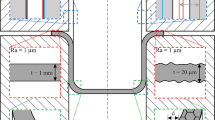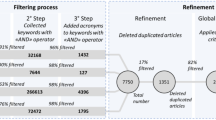Abstract
In order to produce a special machine tool for manufacturing high-quality globoidal cams, this paper presents a systematic approach for tolerance analysis and tolerance allocation for the special machine tool. Based on the differential geometry and conjugate theory, the machined surface and the surface deviation of a globoidal cam are derived with the help of a VS software. The sensitivity model and the worst-case method are applied to analyze the effects of machine tool errors on the machined surface deviation. Manufacture easiness index which can evaluate the level of manufacture difficulty and can also indirectly imply manufacture cost is proposed. Then, the optimization problems are formulated to the maximize manufacture easiness index subject to quality target of cam surface and manufacture constraints. The optimization results are obtained by using MATLAB implementation of linear programming. To confirm the optimization results, they are applied as a guideline to design and manufacture this special machine tool. After that, a globoidal cam is manufactured on this machine tool and measured on a coordinate measuring machine (CMM). The measuring results demonstrate the effectiveness of the proposed approach.
Similar content being viewed by others

References
Yan HS, Chen HH (1996) Geometry design of globoidal cams with generalized meshing turret-rollers. ASME J Mech Des 118:243–249
Backhouse CJ, Jones JR (1990) Envelope theory applied to globoidal cam surface geometry. Proc Inst Mech Eng Part C-J Eng Mech Eng Sci 204:409–416
Ji S, Zhao J, Zhang Y (2015) An application of geodesics to the calculation of the rib-thickness of globoidal cam mechanisms. Mech Mach Theory 87:163–176
Tsay DM, Ho HC (2001) Consideration of manufacturing parameters in the design of grooved globoidal cam indexing mechanisms. Proc Inst Mech Eng Part C–J Eng Mech Eng Sci 215:95–103
Cheng HY (2002) Optimum tolerances for globoidal cam mechanisms. JSME Int J Ser C Mech Syst Mach Elem Manuf 45(2):519–526
Wang WH, Tseng CH, Tsay CB (1999) On the optimization of spatial cam mechanisms considering mechanical errors. Int J Model Simul 19(1):94–100
Chang WT, Wu L (2013) Tolerance analysis and synthesis of cam-modulated linkages. Math Comput Model 57(3–4):641–660
Geetha K, Ravindran D, Siva Kumar M, Islam MN (2015) Concurrent tolerance allocation and scheduling for complex assemblies. Robot Comput-Integr Manuf 35:84–95
Hsueh CC, Lin PD, Sasian J (2010) Worst-case-based methodology for tolerance analysis and tolerance allocation of optical systems. Appl Opt 49(31):6179–6188
Mansuy M, Giordano M, Hernandez P (2011) A new calculation method for the worst case tolerance analysis and synthesis in stack-type assemblies. Comput Aided Des 43:1118–1125
Zhu H, Zhou X, Li H (2015) A novel tolerance analysis for mechanical assemblies based on Convex Method and non-probabilistic set theory. Int J Adv Manuf Technol. doi:10.1007/s00170-015-7634-9
Schleich B, Wartzack S (2015) Evaluation of geometric tolerances and generation of variational part representatives for tolerance analysis. Int J Adv Manuf Technol 79:959–983
Creveling CM (1997) Tolerance design: a handbook for developing optimal specifications. Addison-Wesley, Boston, pp 124–148
Gaurav A (2006) Statistical tolerance analysis and allocation for assemblies using tolerance-maps. Dissertation, Arizona State University
Chase KM (1991) A survey of research in the application of tolerance analysis to the design of mechanical assemblies. Res Eng Des 3:23–37
Nigam SD, Turner JU (1995) Review of statistical approaches to tolerance analysis. Comput Aided Des 27:6–15
Hong YS, Chang TC (2002) A comprehensive review of tolerancing research. Int J Prod Res 40(11):2425–2459
Singh PK, Jain PK, Jain SC (2009) Important issues in tolerance design of mechanical assemblies. Part 1: tolerance analysis. Proc Inst Mech Eng Part B-J Eng Manuf 223:1225–1247
Govindaluri MS, Shin S, Cho BR (2004) Tolerance optimization using the Lambert W function: an empirical approach. Int J Prod Res 42(16):3235–3251
Spotts MF (1973) Allocation of tolerances to minimize cost of assembly. ASME J Eng Ind 95:762–764
AL-Ansary MD, Deiab IM (1997) Concurrent optimization of design and machining tolerances using the genetic algorithms method. Int J Mach Tools Manuf 37(12):1721–1731
Lee WJ, Woo TC, Chou SY (1993) Tolerance synthesis for nonlinear systems based on nonlinear programming. IIE Trans 25(1):51–61
Sfantsikopoulos MM (1990) A cost-tolerance analytical approach for design and manufacturing. Int J Adv Manuf Technol 5:126–134
Yeo SH, Ngoi BKA, Poh LS, Hang C (1997) Cost-tolerance relationships for non-traditional machining processes. Int J Adv Manuf Technol 13:35–41
Zhang C, Wang HP (1998) Robust design of assembly and machining tolerance allocations. IIE Trans 30:17–29
Singh PK, Jain PK, Jain SC (2009) Important issues in tolerance design of mechanical assemblies. Part 2: tolerance synthesis. Proc Inst Mech Eng Part B-J Eng Manuf 223:1249–1287
Wang Y, Zhai WJ, Yang LP, Wu WG, Ji SP, Ma YL (2007) Study on the tolerance allocation optimization by fuzzy-set weight-center evaluation method. Int J Adv Manuf Technol 33:317–322
Li Z, Kokkolaras M, Papalambros P, Hu SJ (2008) Product and process tolerance allocation in multistation compliant assembly using analytical target cascading. ASME J Mech Des 130:091701-1–091701-9
Prabhaharan G, Asokan P, Ramesh P, Rajendran S (2004) Genetic-algorithm-based optimal tolerance allocation using a least-cost model. Int J Adv Manuf Technol 24:647–660
Author information
Authors and Affiliations
Corresponding author
Rights and permissions
About this article
Cite this article
Zhang, Y., Ji, S., Zhao, J. et al. Tolerance analysis and allocation of special machine tool for manufacturing globoidal cams. Int J Adv Manuf Technol 87, 1597–1607 (2016). https://doi.org/10.1007/s00170-016-8558-8
Received:
Accepted:
Published:
Issue Date:
DOI: https://doi.org/10.1007/s00170-016-8558-8



